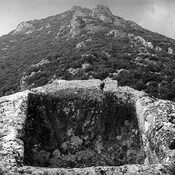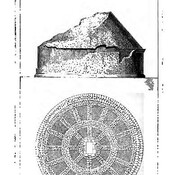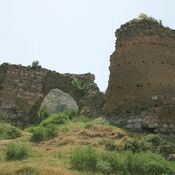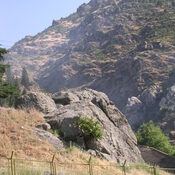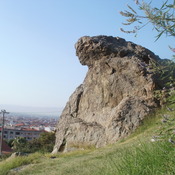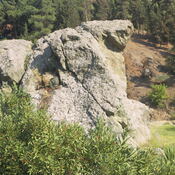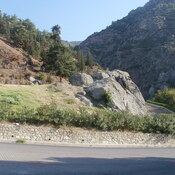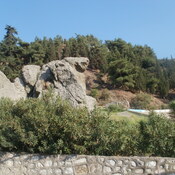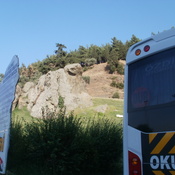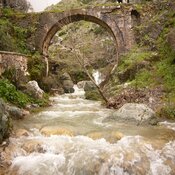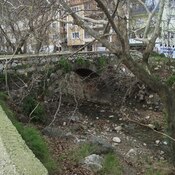The Kybele Rock Relief was curved into the N-E side of Mt. Sipylus n high relief. It portrays a women sitting on a flat rock. The four Hittite hierogliphs are hardly visible n a frame to the right of the goddess head. Dimensions:8 m heigh and 4.5 m wide. There are two inscriptions: one ca 3 m to its right side might be read Zu(wa)-wa/i-ni and one to the left read by Bossert as Ku(wa)lanamuwa or Ku(wa)lamuwa. The identification among some scholars is that the figure is a male with a beard i.e. Hittite mountain god - Sarruma. Kuwalanamuwa is attested in Hittite texts of Mursilis II (ca. 1321–1295 BC) as some commander. In the second century AD, Pausanias recorded the figure in his Description of Greece as a depiction of the mother goddess, Cybele, made by Broteas the son of Tantalos1.
Sources:
- Pausanias, Description of Greece, London, William Heinemann Ltd. 1918. 3.22.4
- http://www.hittitemonuments.com/akpinar/
- George E. Bean, Aegean Turkey, London Benn Ltd., 1966
- Ekrem Akurgal, Ancient Civilizations and Ruins of Turkey, 2nd ed., Istanbul 1970, p. 132,133
- http://anatolianscripts.com/script/sipylos-inscriptions/
- John David Hawkins,"Commentaries on the readings," in Bogazköy-Hattusa 22, 2005.p. 298.
- idem: Hittite Monuments and Their Sanctity, in: Sacred Landscapes of Hittites and Luwians: Proceedings of the International Conference in Honour of Franca Pecchioli Daddi Florence, February 6th-8th 2014,pp. 2-3
- Andre-Salvini, B. and M. Salvini. "Fixa cacumine montis: Nouvelles Considerations sur le relief rupestre de la pretendue 'Niobe' du mont Sipyle" in Collectanea Orientalia. Historie, arts de l'escape et Industrie de la Terre. Paris, 1996, pp. 7-20.
- Horst Ehringhaus, Götter, Herrscher, Inschriften, Mainz am Rhein, 2005, pp. 84-87.
- H. G. Güterbock, and R. L. Alexander. "The Second Inscription on Mount Sipylus", Anatolian Studies 33, 1983, pp. 29-32.
- Kay Kohlmeyer, "Felsbilder der hethitischen Großreichszeit," Acta Praehistorica et Archaeologica 15, 1983, pp. 7-154
- Massimo Poetto, "In margine alla seconda iscrizione luvio-geroglifica del monte Sipylos," Vicino Oriente 7, 1988, pp 171-76.
- Rostislav Oreshko, "Hieroglyphic Inscriptions of Western Anatolia," in Luwian Identities (CHANE 64), 201, pp. 345-420
References
- ↑and some thirty stades farther is Acriae, a city on the coast. Well worth seeing here are a temple and marble image of the Mother of the Gods. The people of Acriae say that this is the oldest sanctuary of this goddess in the Peloponnesus, although the Magnesians, who live to the north of Mount Sipylus, have on the rock Coddinus the most ancient of all the images of the Mother of the gods. The Magnesians say that it was made by Broteas the son of Tantalus.







